Mennonite, Brethren healthy volunteer group reunites at Clinical Center
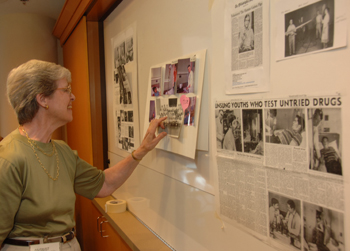 |
|
Ruth Martin, one of the visitors from the faith communities, looks at the collections of photos and articles brought by participants in the reunion to share with the group.
|
by Jenny Haliski
Eating only lima beans. Sleeping with weights on your eyes. Drinking a mixture of corn oil and skim milk. It might seem strange now, but these were some of the diets that a group of Mennonites and Church of the Brethren members who served as healthy volunteers consumed while participating in clinical research studies at the Clinical Center from 1954 to 1975. About 25 volunteers, together with their family members, reunited on Sept. 8 at the CC and traced how their contributions decades ago changed the course of clinical research for the better.
The reunion, spearheaded by Dr. Jim Conrad, a member of the Mennonite Church from Perkasie, Pa., provided an opportunity for the group to reflect on their experiences as "creatures made in the image of God need to express God’s love by how we live our lives." For these faith communities, service to those who are ill provides a powerful metaphor for assisting brothers and sisters in need by choosing "another way of living." Both groups are recognized peace churches affiliated with the National Service Board for Religious Objectors, now the Center on Conscience & War.
One of the volunteers recounted how his mother often said to him, "Someday you’ll serve your country in the Brethren Volunteer Service (BVS) instead of the military." Local draft boards accepted boys' participation in public service projects in lieu of military service. Girls from both churches generally contributed one or two years to youth service activities, such as medical or social work.
CC Director Dr. John I. Gallin noted that like many of the researchers in his generation who joined the U.S. Public Health Service, healthy Mennonite and Brethren volunteers also share a commitment to "save life and not destroy it," to quote former president Franklin D. Roosevelt’s 1940 NIH dedication speech. Although many came to the USPHS during the Vietnam War from 1959 to 1975, the Mennonite and Brethren volunteers came to NIH as early as the Korean War in 1954.
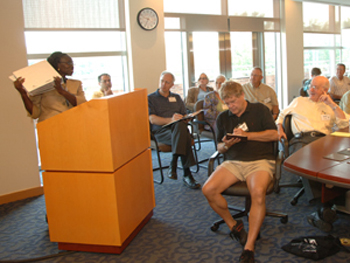 |
|
Mandy Jawara (at podium), coordinator for the Clinical Research Volunteer Program, updates the group on how recruitment of healthy volunteers has changed since they participated.
|
Mandy Jawara from the CC Office of Patient Recruitment & Public Liaison updated the group on the Clinical Research Volunteer Program, which began in 1954 as a collaboration between NIH and the Mennonite and Brethren church’s service agencies, which in turn formed their own volunteer services. Until 2006, 50 to 100 students a year came to live at the CC while participating in clinical research and earning academic credit for their service. Jawara, who coordinates the program, said that although it has changed—healthy volunteer students no longer live on the patient care units—its mission of providing assistance to ICs whose research involves healthy volunteers remains the same.
In his welcome to the group, Gallin described the numerous medical advances from CC history—none of which would have been possible without healthy volunteers’ participation as control subjects. "We will never be able to thank you appropriately. Your contributions to society have been enormous," Gallin said. Dr. Allan Mirsky of NIMH and Dr. Robert Shamburek of NHLBI both provided detailed presentations on the clinical impact of the group’s assistance on mental and cardiac health research.
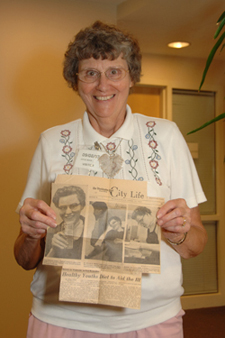 |
|
Joyce Bohn displays a 1957 Washington Post article describing her experience as a healthy volunteer at NIH.
Bohn, who came from a family of 10 children and couldn't afford college, was one of several in the group who received a year of tuition at American University in exchange for her services as a healthy control subject.
Bohn bonded so closely with her roommate, an osteoporosis patient, that she loaned Bohn all of her university expenses without interest so she could continue her studies and the two friends would not be separated.
Taking the roommate up on her offer, Bohn met her husband at the Church of the Brethren's Bridgewater College. "My life changed tremendously because of NIH," Bohn said, wiping away her tears.
|
According to Mirsky, many volunteer control patients helped NIMH researchers to standardize tests of attention, in part by participating in a 1956 study that has been cited in the literature more than 1,000 times and led to the development of the continuous performance test (CPT). Thanks to these volunteer control patients, NIMH researchers also compared psychological test performance in seizure disorder patients; described behavioral effects of the first effective anti-psychotic drugs used to treat schizophrenia; contrasted behavioral and physiological effects of anti-psychotic drugs and sedatives; contrasted effects of anti-psychotic drugs in healthy volunteers and patients; and described effects of stimulant drugs in healthy volunteers through sleep deprivation studies. Mirsky reminisced about coming to campus in the middle of the night to play billiards with a BVS volunteer who hadn’t slept for 70 hours. "She couldn’t do a CPT, but she could complete more challenging tests, including beating me at pool!"
Many cardiovascular and lipid concepts now taken for granted and taught in medical school were major new findings from protocols in the 1960s. The NHLBI investigators leading protocols that included these volunteer control patients reads like a who’s who list of leaders in the field of lipid research, including Drs. Michael Brown and Joseph Goldstein, who won the 1985 Nobel Prize for their work with cholesterol that led to the development of statins; Eugene Braunwald, the first Heart Institute chief of cardiology, author of more than 1,000 publications, and editor of the definitive Braunwald’s Heart Disease text; Frederic Bartter, discoverer of five different metabolic syndromes; and Donald Fredrickson and Robert Levy, the first to describe the movement of HDL and LDL through the blood stream.
The Amish and Mennonite populations have the highest percentage of a rare genetic disorder called sitosterolemia, in which plant cholesterol becomes extremely high because the body is unable to excrete it into the bile for removal from the body. By observing volunteers from these communities, researchers developed drugs to block cholesterol’s absorption in the intestines that are now used in millions of patients with ordinary cholesterol disorders. Marian Payne, a normal volunteer in 1956 who returned to the CC in the late 1990s as a sitosterolemia patient and participated in investigational treatments, said that if it wasn’t for NIH’s research, "I wouldn’t be here today or be in the health I enjoy today."
Shamburek also unearthed hundreds of historic documents to show the group, including media coverage from the time, much of which brought exclamations from his audience as several people present recognized themselves. Five decades ago, NHLBI, NIMH, NIAID, NIAMS, NEI, NCI, and NIDCR conducted most of the protocols at the CC, but these few ICs attracted many volunteers. Some of the documents showed how CC procedures and culture have changed. Each volunteer had a clothing reconciliation list recording all the items they arrived and left with. Before the 1970s, patient initials were published with the studies that they participated in. Several photos depicted physicians and nurses taking cigarette breaks within the hospital. Other items attested to the continuity of human nature, such as the incident reports noting when a volunteer ate cake when he shouldn’t have or lost 75 cents and his car keys in the gym.
The outstanding service of CC staff from decades ago, as well as those today who have served members of their community coming to the CC for studies more recently, also made an impression on these volunteers. "I didn’t know that doctors were like this," one participant said, noting how impressed she was with the "incredible kind of attention" CC staff pay to patients, how they explain things and demonstrate teamwork.
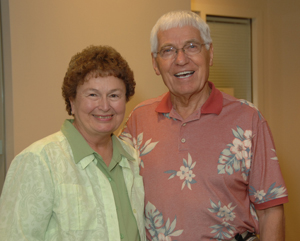 |
|
Judy and George Reimer met at the CC and married shortly after their time here.
|
After tours of the new Hatfield Building, the group reconvened to tell stories of their experiences and pore over photos and articles brought to share with the group. Their recollections shared a common theme: how much their life changed as a result of coming to the CC. Carson Good discovered the social work profession, which became his career path, during his time at the CC. Two couples in the group—Marilyn and Dave Verbeck and George and Judy Reimer—met at the CC and married shortly after their time here.
The volunteers, all of whom were 18 years or older, many of them away from their rural community for the first time when they came to NIH, especially appreciated the exposure to diverse cultures in the Washington, D.C. area that they enjoyed in their free time, such as attending Washington Senators baseball games, boating on the Potomac, or attending concerts and sporting events. One participant said, "The culture and social learning we received while at NIH molded our lives to this very day."
Back to Top
Astute Clinician lecture focuses on coronary disease
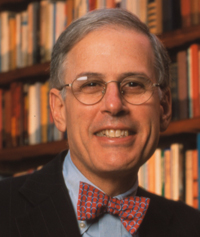 |
|
Dr. Barry Coller, who will give the 2007 Astute Clinician lecture.
|
by Jenny Haliski
"From the Rivers of Babylon to the Coronary Blood Stream" will be the subject of the 2007 Astute Clinician Lecture, on Wednesday, Nov. 7 at 3 p.m. in Masur Auditorium.
The speaker will be Dr. Barry Coller, David Rockefeller Professor of Medicine; head of Laboratory of Blood and Vascular Biology; and physician-in-chief of the Rockefeller University Hospital. He is also vice president for medical affairs at the Rockefeller University.
A graduate of Columbia College and New York University School of Medicine, Coller’s research interests focus on hemostasis, thrombosis, and platelet physiology in particular.
Coller and his colleagues studied patients with the platelet disorder Glanzmann thrombasthenia, which affects about one person in a million and involves lifelong excessive bleeding. These clinical observations helped them to develop therapeutic and diagnostic strategies for coronary artery disease, one of the most common causes of death in the world.
Coller studied a defect in these patients’ platelets that affects the platelets' ability to aggregate. Based on this knowledge, Coller’s laboratory developed an antibody that blocks the ability of normal platelets to aggregate. A derivative of that antibody (abciximab) received FDA approval in 1994 and has been used to treat more than two million patients worldwide to prevent complications of coronary interventions such as angioplasty and stent insertion. Treatment with abciximab prevents clots from forming in stents used to open the diseased arteries in patients with heart attacks. A recipient or co-recipient of 13 U.S. patents, Coller also developed an assay to assess platelet function and has received FDA approval to monitor antiplatelet therapy with aspirin and other agents.
Coller has received numerous awards, including the American Society of Hematology’s Henry M. Stratton Medal and the Robert J. and Claire Pasarow Foundation Award for Cardiovascular Research in 2005.
His antibody in1995 was named best new therapeutic product by the Biotechnology Industry Organization and innovation of the year by Pharmazeutische Zeitung. In 1997 he was named inventor of the year by the New York Intellectual Property Law Association and received the International Society on Thrombosis and Haemostasis’ distinguished career award.
Coller is a member of the Association of American Physicians, the Institute of Medicine of the National Academies, and the National Academy of Sciences. He is a Fellow of the New York Academy of Medicine, the American Association for the Advancement of Science, and the American Academy of Arts & Sciences, and a Master of the American College of Physicians.
He has served as a member of NHLBI’s Board of Extramural Advisors and co-chair of NIH’s Advisory Board for Clinical Research. He also worked at the Clinical Center from 1972 to 1976 in the Clinical Pathology Department’s Hematology Service.
The Astute Clinician Lecture was established through a gift from the late Dr. Robert W. Miller and his wife, Haruko. It honors a U.S. scientist who has observed an unusual clinical occurrence, and by investigating it, has opened an important new avenue of research.
The Astute Clinician Lecture is an NIH Director’s Wednesday Afternoon Lecture Series event. It is hosted by the Clinical Center.
For information and accommodations, contact Gloria Hairston at 301-594-6747.
Back to Top
7SE's 'cozy committee' warms area for patients and staff
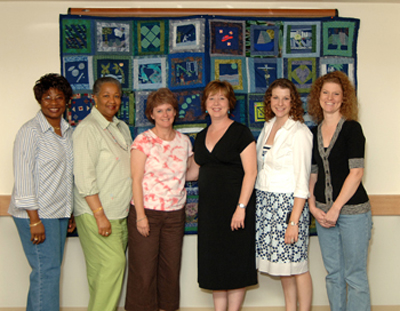 |
|
(from left) Cozy committee members Donna Owolabi, clinical research nurse; Sybil Barnaby, clinical manager; Valerie Greene, clinical research nurse; Susan Krutis, occupational therapist and committee co-leader; Mary Carson, recreational therapist and committee co-leader; and Wendy Pettit, social worker, stand in front of their community quilt.
Committee members not pictured: Martha Bernad, vocational counselor; Paula Jacob, clinical research nurse; Christine Kotila, clinical research nurse; Megan Robb, art therapist; and Naomi Yett, behavioral health technician.
|
by Jenny Haliski
When the Clinical Center’s inpatient adult behavioral health unit moved to 7SE from 4 East, it gained a larger, cleaner space with wide hallways, a modern look, and easy adaptability to provide other types of clinical care. Although they appreciated the new hospital, some patients and staff missed how they interacted in their old, more personalized area. Unit staff noticed that some patients, for whom isolation can be a problem that exacerbates symptoms of their condition, were spending more time in their rooms.
Responding to feedback from staff that the space might need to be fine-tuned to better meet the environmental needs of a psychiatric population, occupational therapist Susan Krutis in summer 2006 launched the cozy committee and invited CC staff from all disciplines to participate. The only requirements co-leaders Krutis and recreational therapist Mary Carson asked: openness to bringing all ideas to the table and willingness to work on projects between meetings.
"We needed to draw patients out into the day hall and make it a comfortable and cozier place," Carson said. "We try to make it feel like a home away from home for our patients, who are volunteering for months in clinical trials. Uncomfortable surroundings could have an impact on patients’ responses to the research."
Staff surveyed patients for suggestions to make the area cozier. Some of the first additions included plants in the hallways, comfortable chairs with throw blankets in the group areas, bulletin boards in a central location listing patient education and recreation activities, and magnets for the dry erase boards on patient closets for displaying art and photos from home.
Many of the new items also become tools for the staff to teach independent living skills. Patients previously used cardboard boxes or plastic bags to transport clothes from their rooms to the laundry area. New portable plastic laundry hampers are now stored in each closet. All patients on the floor use them, reinforcing a routine they can take with them after discharge.
The most creative collaboration so far between 7SE staff and patients is a two-piece community quilt started in January and completed a few months later. Aside from the unifying green and blue colors, quilters could express anything they chose. Each of the unit’s two day areas will display half of the quilt, one for the anxiety and depression program and one for the schizophrenia program.
Krutis said the committee boosts staff and patient morale by providing a recognized format to address issues, act on them, and institute positive changes on the unit. "Complaints often arise as individuals negotiate for their preferences. Finding a way to talk about those issues creates new ways to consider the rationale behind decisions and find new ways to answer questions or concerns. Good ideas often come from this process."
Back to Top
DTM unveils research donor computer-assisted self-registration
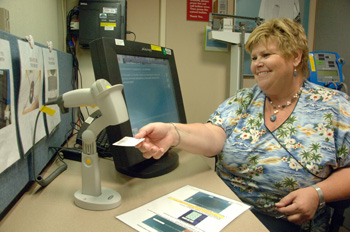 |
|
Gail Birmingham, clinical nurse educator in DTM, demonstrates the new touch-screen computer-assisted self-registration for research blood donors.
The signs hanging in the cubicle remind donors to scan their blood donor identification card, use the touch screen to enter their responses, and avoid using the computer's mouse or keyboard.
|
Healthy volunteers donating blood earmarked for research protocols this summer caught an early peek at the Department of Transfusion Medicine’s new self-registration questionnaire (SRQ). It is a touch-screen, computer-assisted system. DTM plans to introduce the SRQ to all transfusion blood donors by March.
The new system is the second phase of a plan to increase the safety and security of donor screening, make most of the process paperless, and increase staff accessibility to archived donor records. DTM took the first step in June 2006 when it introduced computerized screening and phlebotomy functions to manage several processes when a donor first arrives. The department uses computers to record vital signs and hemoglobin levels and facilitate viral testing and type matching of blood products.
Before DTM staff began using the new system with research donors at the end of June, each staff member practiced at least seven screening scenarios and attended two sessions providing an overview of the system, according to Gail Birmingham, clinical nurse educator.
Julie Hopkins, blood services nurse manager, said it made sense to "work out the kinks" in the transition to the new technology by introducing the computerized questionnaire to research donors first. DTM staff rotate through sections of the department about once a month, so all will have hands-on exposure to the new system before it is introduced to transfusion donors. Research donors’ visits take longer and they are a smaller group—she estimates that they see about 15 research donors each day, compared to 30 to 40 transfusion donors each day. About 200 NIH-affiliated investigators each week receive blood products from research donors, who serve as the normal controls for protocols involving studying a patient’s blood.
Research apheresis donors can give blood more frequently—about every three weeks—because not all of their blood is used. Blood is often separated by centrifugation to isolate and provide investigators with just the type of cells they need. The other blood components are given back to the donor. Research donors also answer a shorter questionnaire at each visit, as their blood is not transfused to another individual.
Nearly all DTM’s regular research donors have now used the new system successfully. DTM staff found that as touch-screen technology is more common in other parts of daily life, research donors easily adapted to the paperless, interactive system. It also affords donors a greater sense of privacy. Instead of noting all their answers on a piece of paper or having to verbally discuss every question with a screener, donors silently touch the response on a screen that disappears once the question is answered.
Another benefit of computer-assisted interviewing over face-to-face techniques is the lower rates of errors or omissions on donor screening forms. The computer program will not allow either the donor or the screener to proceed without a response to each item. Donors do have the opportunity to flag questions that they may not understand or may have a question about, scroll through all their responses, and answer flagged questions later. The computerized responses also eliminates illegible handwriting.
Janet Browning, DTM database manager, said that the SRQ eliminates one of the "pet peeves" of frequent donors: repeated questions that couldn’t possibly apply to you, such as asking a male donor if he is pregnant. "The computer knows if you’re a female, according to DTM records, and only asks you the pregnancy question if you qualify."
As researchers make new discoveries and connections between diseases and blood products, the questions that blood banks ask donors change. For example, since the advent of mad cow disease, donors are asked about time in countries where they might have been exposed. The new computer system will allow DTM staff to add and remove questions.
Donors who dislike reading large chunks of text will appreciate the format of the new system. DTM staff divided related series of questions into individual screens, so a maximum of three lines of text appear on each screen. The final screen allows the donor to scroll through and review all responses.
To speed the screening process, all donors should make a habit of bringing their identification cards with them to each visit. The barcode on the card must be scanned into the computer to start the check-in process. Donors who forget or lose their card will have to wait an additional five to 10 minutes for DTM staff to print a new card before they can access the system.
Back to Top
Donna Gwyer retires after 20 years at CC, 41 years as nurse
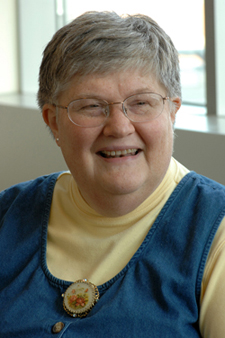 |
|
Retiring CC nurse Donna Gwyer
|
by Louise Canada
Clinical Center nurse Donna Gwyer always wanted to work with children, either as a teacher or nurse. Her work on the CC’s pediatric units, most recently the 1NW day hospital and 1 SE clinic, enabled her to live that dream. Her retirement at the end of September marks 20 years of service to the CC and 41 years as a nurse.
Born in Spartansburg, Pa., Gwyer graduated from Ohio’s Trumbull Memorial Hospital School of Nursing in 1966; Pennsylvania State University with a Bachelor of Science in nursing in 1969; and the University of Maryland with a Master of Science in nursing and health policy in 1998. She joined the U.S. Army Nurse Corps and was stationed as a pediatric nurse manager with the 30th Field Hospital in Augsburg, Germany, and the Walter Reed Army Medical Center in Washington, D.C.
While at Walter Reed in the 1970s, Gwyer discovered the value of clinical research at NIH and resolved to work here at some point in her career. One of Gwyer’s infant patients was diagnosed with Menkes kinky hair disease, a rare genetic syndrome of copper metabolism, and was transferred to NIH for a protocol using infusions of copper sulfate as treatment. But before she arrived at NIH in 1987, Gwyer worked at the Madigan Army Medical Center in Tacoma, Wash.; the Dwight David Eisenhower Army Medical Center in Fort Gordon, Ga.; the Fairfax County Health Department in Va.; the Pediatric Specialties Clinic at Loyola University Medical Center in Chicago, Ill.; the Placer County Health Department in Auburn, Calif.; Columbus Children’s Hospital in Columbus, Ohio; and the McCook Community Hospital in McCook, Neb.
At the CC, Gwyer also worked on the 5 West and 5 East neurology units, 9 West and 9 West day hospital and pediatric research units, the 8 West endocrine unit, and the 11 East multi-institute pediatric unit. In addition, she has been a very active member of the editorial board for the chief nurse’s annual report and many other nursing department committees during her 20 years at NIH. "What I love about the NIH is that nurses are respected and valued as active members of the medical team, involved in all aspects of patient care and research," Gwyer said. "It is a hospital that accepts and encourages growth and development of the nursing staff. It is wonderful for nurses to have so many career paths to choose from, all of which are accepted and supported."
Gwyer will retire to a quieter lifestyle in western Pennsylvania on her brother’s farm. This Christmas her twin daughters, Bridgett and Meghan, and their spouses will visit her there. Gwyer will vacation in Scandinavia in January 2008.
Back to Top
New recreation therapy chief to join CC in November
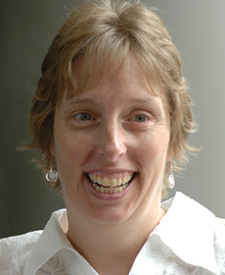 |
|
Donna Gregory, new chief of recreation therapy
|
In mid-November, Donna Gregory will join the Clinical Center’s Rehabilitation Medicine Department as chief of the recreation therapy section. She brings to the role 20 years of experience and leadership as a recreation therapist in hospital-based physical medicine and rehabilitation settings and on programs for children and families living with cancer. She replaces Dr. George Patrick, who retired from the position in June 2006.
Gregory earned a master’s degree in business administration from Pennsylvania State University in 2003 and a Bachelor of Science in therapeutic recreation from the University of Maryland in 1988. Although she began college as a special education major, Gregory soon discovered that she was drawn more to the health-care environment. "I’m most passionate about helping patients maintain and enhance their quality of life despite whatever challenges they may face," Gregory said.
After earning her undergraduate degree, Gregory spent five years as a recreation therapist with the National Rehabilitation Hospital’s programs for patients with brain injuries. She then spent 13 years in Philadelphia working for Bryn Mawr Rehabilitation Hospital, as a therapeutic recreation director, day treatment program director, and outpatient operations director. Gregory hopes to combine her experience in management, program development, and working with brain injury patients to developing the CC’s growing relationship with Walter Reed Medical Center outpatients.
A native of Silver Spring, Gregory returned to her hometown in November 2006, when she joined the Children’s Inn at NIH as an education and youth initiatives coordinator. There she developed educational programs for pediatric patients and their families and collaborated with CC staff on services to complement clinical treatment. Gregory said that "growing up in this region, and then studying recreation therapy, I always knew of the Clinical Center as a premiere place to work because of the diversity of the patient population, both from a cultural as well as a diagnostic perspective." The quality of the CC’s recreation therapists, with their practice longevity, involvement in professional organizations, numerous publications, and access to state-of-the art assistive technology and resources, also attracted her to the position.
Since 1987 Gregory has volunteered with Special Love Inc., which sponsors Camp Fantastic and 17 year-round programs for children with cancer and their families. As a volunteer leader, program committee member, and challenger course instructor, Gregory acts as a liaison between medical teams and program staff at Camp Fantastic in the addressing of clinical needs of campers while integrating clinical staff in non-medical activities. She also created activities customized to meet the unique needs of siblings dealing with a sick brother or sister.
Dr. Leighton Chan, CC RMD chief, said that Gregory is "already a member of the NIH family" through her many years of volunteer work with Camp Fantastic and more recent position at the Children’s Inn. "Those who know Donna describe her as full of positive energy. We were very lucky to hire her," Chan said.
Back to Top
News Briefs
John Doppman Memorial Lecture
The annual John Doppman Memorial Lecture for Imaging Sciences will be presented by Dr. J. William Charboneau, professor of radiology at the Mayo Clinic College of Medicine, on Wednesday, Oct. 31 from noon to 1 p.m. in Lipsett Amphitheater. Charboneau’s topic is "Image-Guided Cancer Treatment: The Science and Vision of an Emerging Field."
Fifth Annual Clinical Investigator Student Trainee Forum
Medical and dental students participating in clinical and translational research fellowships at academic medical centers and at NIH will gather Oct. 24-26 to meet with their peers, program leaders, and leading clinical and translational researchers from around the country. A program of lectures, panels, and workshops will allow the participants to learn more about recent biomedical advances and academic careers in clinical research, as well as to interact with their peers in similar programs. For more information, call Kenny Williams at 301-402-9863.
Fall brown bag series
The CC Office of Workforce Planning and Development will host a fall leadership development brown bag series. Space is limited, so please RSVP to Yasmin Coates at ycoates@cc.nih.gov or 301-402-5285.
Oct. 25: "What is ‘reasonable’ accomodation? Addressing employees with medical issues"—Robin Wink, room 2-3750.
Nov. 15: Project Management: Essentials for Leaders—Denise Ford, room 4-2551.
Dec. 6: Use and Abuse: Making sense of the myriad of federal leave policies—Robin Wink, room 4-2551.
Not just a job
Robert DeChristoforo, interim chief of the CC Pharmacy Department, recently published a commentary in the Reflections column of the American Journal of Health-System Pharmacy describing his experiences at the CC and the research developments he has witnessed during his 28-year career. DeChristoforo writes, "The most moving and emotional aspect of my job is working with our research participants, who in some cases look to NIH as their last hope for a cure." Although all participants learn in the informed-consent process that they might not benefit from enrollment in a research protocol, "many also realize that they may be helping others in the future, even if the study will not help them in the short term. There certainly is no shortage of altruism in the halls of NIH’s Clinical Center." He concludes, "To paraphrase the immortal words of Lou Gehrig, I truly can say that ‘Today I consider myself the luckiest pharmacist on the face of this earth.’" The full text of the article is available online at http://www.ajhp.org/cgi/content/full/64/15/1651.
Back to Top
New clinical research protocols
The following new clinical research protocols were approved in August:
Phase I/II Study Using a Non-Myeloablative Lymphocyte Depleting Regimen of Chemotherapy Followed by Infusion of Allogeneic Tumor-Reactive Lymphocyte Cell Line DMF5 in Metastatic Melanoma, 07-C-0210, Steven A. Rosenberg, MD, NCI
A Phase I Study of ABT-888 in Combination With Topotecan Hydrochloride in Adults With Refractory Solid Tumors and Lymphomas, 07-C-0203, Shivaani Kummar, MD, NCI
A Pilot Study of Tumor Vaccination in Patients with Neuroblastoma and Pediatric Sarcomas and Altered T-Cell Homeostasis, 07-C-0206, Crystal L. Mackall, MD, NCI
An Investigation of the Efficacy of the Glutamate Transporter GLT 1 in the Treatment of Bipolar Depression, 07-M-0201, Carlos A. Zarate, MD, NIMH
Deliberation With and Without Attention: Can We Enhance Informed Choices About Invasive Prenatal Testing? A Proof of Principle Study, 07-HG-0204, Barbara B. Biesecker, NHGRI
An Observational Study of the Immunopathogenesis of and Response to Step-Up Inflammatory Bowel Disease Therapy for Hermansky-Pudlak Syndrome-Associated Colitis, 07-I-0205, Peter J. Mannon, MD, NIAID
A Phase 2, Open Label, Crossover Pharmacokinetic and Pharmacodynamic Study to Compare Chronocort Versus Cortef in Patients with CAH, 07-CH-0211, Deborah P. Merke, MD, CC
Prospective Evaluation of Albuminuria in HIV Positive Patients, 07-DK-0212, Jeffrey B. Kopp, MD, NIDDK
Thyroid Hormones Homeostasis and Energy Metabolism Changes During Exposure to Cold Temperature in Humans, 07-DK-0202, Francesco S. Celi, MD, NIDDK
Tenofovir Disoproxil Fumarate Alone Versus its Combination with Emtricitabine for Treatment of Chronic Hepatitis B, 07-DK-0207, Marc G. Ghany, MD, NIDDK
Back to Top
Foil-the-flu program announces 2007 dates
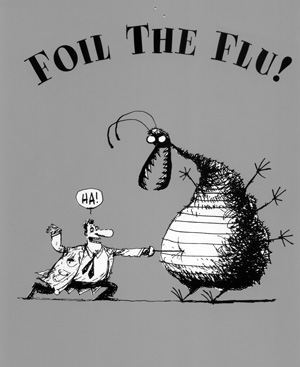 |
The foil-the-flu campaign's logo
|
Flu vaccine is available for NIH employees only (not contractors). An NIH photo ID is required.
Please dress appropriately. Wear clothing that will let you quickly expose your upper arm. Changing areas will not be available. Vaccinations will be given based on the first letter of the employee’s last name. Employees who show up on the wrong day will be vaccinated but can expect a longer wait.
An open clinic in Occupational Medical Services, 10/6C306, will be open to all NIH employees from Nov. 26-30 from 7:30 a.m. to 11 a.m. and 1-3 p.m. Beginning Dec. 3, 2007 the flu vaccine will be available in OMS by appointment only. Call 301-496-4411. This schedule is also available at www.foiltheflu.nih.gov.
This program is sponsored by the Office of Research Services/OMS; Clinical Center/Hospital Epidemiology Service; and Department of Health and Human Services/NIH.
Building 10, 7th floor atrium east side
| First letter of last name |
Date |
AM |
PM |
| NOPQRS |
10/22 |
8-11 |
1-3:30 |
| ABCD |
10/23 |
8-11 |
1-3:30 |
| EFGH |
10/24 |
8-11 |
1-3:30 |
| IJKLM |
10/25 |
8-11 |
1-3:30 |
| TUVWXYZ |
10/26 |
8-11 |
1-3:30 |
| EFGH |
11/5 |
8-11 |
1-3:30 |
| TUVWXYZ |
11/6 |
8-11 |
1-3:30 |
| NOPQRS |
11/7 |
8-11 |
1-3:30 |
| IJKLM |
11/8 |
8-11 |
1-3:30 |
| ABCD |
11/9 |
8-11 |
1-3:30 |
Off campus sites
| Off-site location |
Date |
AM |
PM |
| TWN 3, Room 2E06, 12735 TB Pkwy |
10/29 |
8:30-11 |
1-3 |
| EPN, Room 103, 6120 Exec Blvd |
10/30, 10/31 |
8:30-11 |
1-3 |
| RKL, Room 5054, 6705 Rockledge Dr |
11/1, 11/2 |
8:30-11 |
1-3 |
| NSC conference room, 6001 Exec Blvd |
11/13 |
8:30-11 |
1-3 |
| Poolesville, Room TBA |
11/14 |
9-12 |
N/A |
Back to Top
Upcoming Events
Clinical Center Grand Rounds, Great Teachers, Ethics, and Medicine for the Public Lectures
Tuesday, October 2—Medicine for the Public
Alcohol Use Disorders: Old Insights, New Treatments
Markus Heilig, M.D., Ph.D.
Clinical Director, NIAAA
Wednesday, October 3—Ethics
Phase 1 Research: Who Should Be Excluded?
Leonard Glantz, J. D.
Associate Dean, Academic Affairs
Professor, Health Law, Bioethics, and Human Rights
Boston University
Tuesday, October 9—Medicine for the Public
The Prevention of Cervical Cancer by Vaccination and Other Means
Douglas Lowy, M.D.
Chief, Laboratory of Cellular Oncology
Center for Cancer Research, NCI
Wednesday, October 10—Great Teachers
Contemporary Clinical Medicine: Great Teachers
The Osteoporosis Revolution
Lawrence G. Raisz, M.D.
Board Trustees Distinguished Professor of Medicine
University of Connecticut Health Center
Lecture will be videocast, http://videocast.nih.gov
Tuesday, October 16—Medicine for the Public
From Childhood Blindness to Age-related Macular Degeneration: Genes, Eye Disease, and Prospects for Therapy
Paul Sieving, M.D., Ph.D.
Director, NEI
Wednesday, October 17
Sialic Acid Deficiency in Myopathy and Nephropathy: Pathogenesis and Treatment
William Gahl, M.D.
Clinical Director, NHGRI
Head, Section on Human Biochemical Genetics, Medical Genetics Branch, NHGRI
Marjan Huizing, Ph.D.
Head, Cell Biology of Metabolic Disorders Unit, Medical Genetics Branch, NHGRI
Wednesday, October 24
Synaptic and Neural Plasticity in the Treatment of Mood Disorders
Husseini K Manji, M.D., F.R.C.P.C.
Director, Mood and Anxiety Disorders Program
Chief, Laboratory of Molecular Pathophysiology, NIMH
New Research Directions in the Treatment of Mood Disorders
Carlos A. Zarate, Jr. M.D.
Chief, Experimental Therapeutics, Mood and Anxiety Disorders Program, NIMH
Tuesday, October 30—Medicine for the Public
Good Pain, Bad Pain: New Advances in Pain Mechanisms and Treatments
Michael J. Iadarola, Ph.D.
Chief, Neurobiology and Pain Therapeutics Section, Laboratory of Sensory Biology, NIDCR
Wednesday, October 31—John Doppman Memorial Lecture
Image-Guided Cancer Treatment: The Science and Vision of an Emerging Field
William Charboneau, M.D.,
Professor of Radiology,
Mayo Clinic
Wednesday, November 7—The Astute Clinician Lecture
From the Rivers of Babylon to the Coronary Blood Stream
Barry Coller, M.D.
Head, Laboratory of Blood and Vascular Biology, Rockefeller University Hospital
Back to Top
Clinical Center News, National
Institutes of Health, Building 10, 10 Center Drive, Room 12C440, Bethesda, MD 20892-1504. Tel: 301-496-6787.
Fax: 301-402-2984. Published monthly for CC employees
by the Office of Communications, Patient Recruitment, and Public Liaison. News, article ideas,
calendar events, letters, and photographs are welcome.
Back to Top
|
|


 The information on this page is archived and provided for reference purposes only.
The information on this page is archived and provided for reference purposes only.